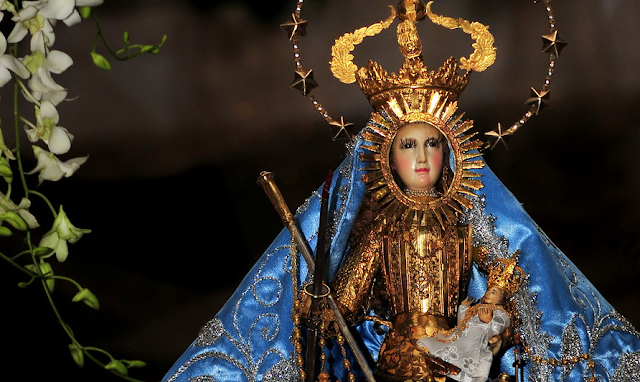Nuestra Señora de Candelaria de Paracale - Patroness and Protectress of Paracale, Camarines Norte
 |
| Nuestra Señora de Candelaria de Paracale |
 |
| Nuestra Señora de Candelaria de Paracale |
The venerable image of Nuestra Señora de Candelaria de Paracale, or "Inay Candi" to her devotees, is a de vestir image of the Madonna and Child with a wooden body and ivory heads, hands and the Child Jesus. the Virgn wears a set of crowns, estrellas, rostrillo, a gold plancha and a set of vestments given by devotees over the years. The Virgin holds a candle, a scepter and a sword in memory of her miracle in Paracale. One distinct feature of the image is the Virgin's broken fingers as a reminder of the miracle she performed to protect her dominion. The Child Jesus on the other hand is smaller and also wears a set of crowns and vestments.
History
Paracale was founded as a mission post by Franciscan friars in 1581. It was established as a town in 1611. However, the mission was abandoned in 1634, reestablished by the Franciscans in 1638 but was abandoned again in 1662. In 1687, the Franciscan missionaries returned to their mission. It was later ceded to the secular clergy. In 1863, Paracale was then formally established as a town. Seventeen years later, the Franciscans returned to Paracale to take charge the spiritual administration of the faithful. A large gold mine was discovered here in 1626 and Spaniards worked the gold-bearing gravel in its rivers and streams.
The image of Nuestra Senora de Candelaria de Paracale of Camarines Norte is considered as the oldest Patroness of Bicolandia with the arrival of the Franciscans in the 17th Century when they brought with them the Ivory image of Our Lady of the Candles and establish the parish in 1611. Based on the old records, kept in the Parish Archives, St. Anthony Abbot appeared as the Patron saint of this parish. The first missionaries led by Fray Jose dela Torre implanted in the hearts of the natives a profound veneration towards the saint.
 |
| Nuestra Señora de Candelaria de Paracale |
According to tradition, way back in the year 1809, August 29 exactly, 185 years ago, 37 Moro Pancos loaded with Moro pirates dropped anchor on the shores of Paracale. This raid was part of intensive and frequent trades of Moro Pirates which, according to the Philippine History, started in 1580 in the Bicol Region. These Moro marauders attracted by the fame of Paracale’s abundance of gold came to our shores, terrorizing the natives, burning their houses, plundering their wealth then killing the inhabitants and carrying captive Christians to Morolandia. At the mere sight of these Moro Pancos the natives were stricken with terror and many of them fled to the mountains leaving their belonging behind.
The faithful would gather inside the church to beseech the Lord and the Blessed Virgin for protection and deliverance from the impending disaster. At this juncture, on August 29, 1809, it is believed that the Virgin left her place from the altar and went to the beach brandishing a shining sword and like a whirlwind she floated over the waves and accosted the Moro marauders with such fury and power that caused havoc and terror among the Moro pirates. This particular miracle explains why the image of the Virgin has broken fingers. Many attempts were made to repair the damage but to no avail for the Virgin wanted to remain in that state as a reminder of her protection to the province.
 |
| The Canonical Corontion of Nuestra Señora de Candelaria de Paracale |
Church Recognition
Due to the great miracles of attributed to the Virgin of the Candles of Paracale, Fray Casimiro Herrera, OSA., Bishop of Nueva Cacere, formally decalred that Nuestra Señora de Candelaria de Paracle as the town's patroness in 1881 upon the request of the Parish Priest and the people of Paracale. In line with the Quadricentennial celebration of the devotion to Inay Candi, the Queen of Camarines Norte was Canonically Crowned on September 1, 2012.
The devotion at present
The devotion to Nuestra Señora de Candelaria de Paracale continues to flourish up to this day. Pilgrims and devotees flock her church, especially on her feast day February 2. For the people of Paracale, the abundance of gold everywhere, it is said, is a gift from God dispensed through the Blessed Virgin, Patroness of Paracale. It is considered as a visible sign of predilection to this erstwhile sleepy little town by the sea, kissed by the neighboring blue Pacific Ocean with its undulating waves flirting with the sparking gold and pyrites.
References:
Delos Reyes, Michael P. "Salve Regina: On Crowning image of the Virgin Mary", Diliman, Quezon City, Claret Communications Foundation Inc., 2015.
"Our Lady of Purification Parish Church", Retrieved from http://www.camarinesnorte.gov.ph/museum/our%20lady%20of%20purification.html on May 10, 2020.
Photos:
Innocencio, Glenn
Yu, Kendrick Dominic
Special thanks to Mr. Glenn Innocencio and Mr. Kendrick "Biggie" Yu for the photographs of Nuestra Señora de Candelaria de Paracale that were utilized for this blogpost.
+AM+DG+





Comments
Post a Comment